2022.07.04.50
Files > Volume 7 > Vol 7 No 4 2022
Detection of heat shock protein 70 genes (HSP70) polymorphism and its relationship with some productive and reproductive traits in local Iraqi goat
Oras Razoqi Waheb 1*, Salih Hassan AL-Azzawi 2
College of Agriculture, University of Diyala
*Corresponding author. [email protected]
Available from: http://dx.doi.org/10.21931/RB/2022.07.04.50
ABSTRACT
The study was conducted on 30 local goats in the Diyala / Al-Khalis governorate belonging to goat breeders. The experimental samples' laboratory work was completed in the College of Agriculture - the University of Diyala and the Office of Scientific Progress - Al-Harithiya - Baghdad from 11/13/2021 to 6/7/ 2022. This study is to demonstrate the relationship between the genetic phenotypes of the heat shock gene (HSP70)in the productive and reproductive to the reproductive and effective performance of local Iraqi female goats. The percentage of genotypes for the C1653T mutation site in the goat sample was 53%, 37% and 10% for the CC, CT and TT genotypes, respectively, and the allelic frequency were 0.71 and 0.29 for the C and T alleles, respectively. The chi-square value was not significant between the genotypes. The genetics indicates that the population is in a state of (Hardy Weinberg) equilibrium (p < 0.05), which suggests that there is no selection pressure in favor of a specific genetic structure for this genetic locus. This mutation had a high effect (P<0.01) on the mortality rate, where the CT genotype was 27% superior to the two genotypes CC, which was 13%, and then the TT genotype had no mortality. As for the traits of milk production (daily and total), it was observed through this study that there was a balance for this mutation in this direction so that there is resistance to heat stress, which negatively affects milk production as the animal is in a state of harmony between resistance to heat stress and milk production. As for growth traits, the C1653T mutation had no significant effect on growth traits. There were no significant differences between the birth weight and weight gain genotypes. Still, concerning the importance of weaning, it was noted that the CC and TT genotypes were superior to the CT genotype (11.92 and 11.92). 11.70 and 10.17) kg, respectively.
Keywords: Hsp70, Milk, litter size.Polymorphism, Iraqi goats.
INTRODUCTION
Goats are considered among the animals that were not raised in most Arab countries, despite the exploitation of this animal in many Asian and African countries for its production of twins. The poor later began to improve these animals, especially since there are breeds that have a broad scope for genetic improvement, which has a role in filling part of the deficit that results from the lack of milk and meat and its high prices 2،6. 5 indicated that heat stress is among the various stresses that animals are exposed. Goats are considered one of the most capable animals in dealing with heat stress without affecting their health or product performance. She suffers from heat stress outside her comfort zone, and heat stress is defined as the imbalance the body produces from metabolic heat inside the body, and it dissipates to the surrounding areas. Heat stress also significantly affects some physiological, behavioral and hematological parameters of goats 1. The importance of selection for animals that are more resistant and more adaptable to these climatic changes and different stress conditions due to their high genetic ability to protect their cells, which works to reduce the effects of heat stress. When exposed to various stress conditions 4, molecular genetics technology enables researchers to use the economically important genes present in certain Breeds and transfer them to other strains 7.
MATERIALS AND METHODS
This study was conducted on a sample of 30 local goats in the governorate Diyala / Al-Khalis belonging to a goat breeder. The laboratory work of the experimental samples was conducted in the laboratory of the College of Agriculture - the University of Diyala and the Office of Scientific Progress - Al-Harithiya - Baghdad for the period from 11/13/2021 to 6/7/ 2022; this study is to demonstrate the relationship of the genetic phenotypes of the heat shock gene HSP70 to the reproductive and productive performance of local Iraqi female goats. The reproductive performance of experimental animals was calculated based on 3 the following rates
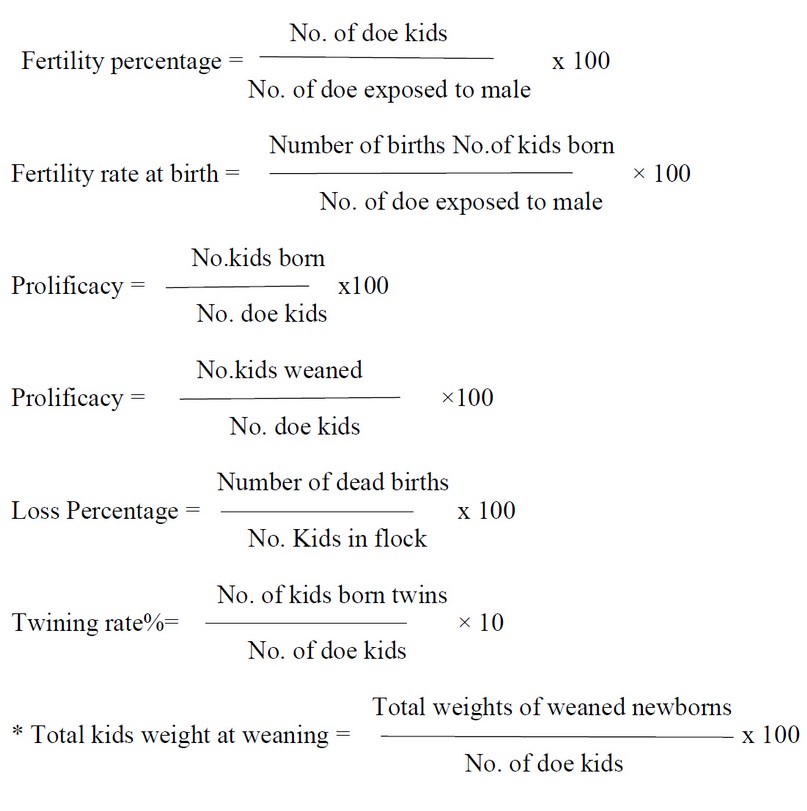
Measuring milk production The daily and total milk production of the experimental animals (30 goats) was calculated by hand milking each goat. The newborns were isolated from their dams at night and for 12 hours from eight in the evening until seven in the morning to milk the goats. The milking process began after the 15th day after birth, where they were. On this day, the first circuit lasted for two months. For each month, the milk was measured twice. A total of 4 measurements according to the following equation:
TMY= M1*2*T+ M2*2*T + M3 *2*T + M4*2*T
TMY= total milk production
M= Milk measurement (M1 the first measurement, M2 the second measurement, M3 the third measurement, M4 the fourth measurement)
T= The period between the two milkings.
The dam's weight at birth was taken using a scale of 150 kg. The weight of the newborns was also measured at birth and at weaning three months after the date of birth using a scale of 150 kg, and then the weight gain before weaning was calculated through the difference between the weight at weaning and the weight at birth according to the following equation:
Weight gain = weaning weight - birthweight.
Blood samples were drawn from the jugular vein, and a 5 ml medical syringe was used after cleaning and sterilizing the area with 70% ethyl alcohol. After the blood was drawn, it was placed in dedicated tubes containing an anticoagulant substance (EDTA). Then these tubes were placed in a freeze at a temperature of 4-C to preserve them until the DNA extraction process was performed. And then, the initiators of the heat shock gene( HSP70), the third piece, were determined. This primer was designed by the Scientific Advancement Company (ASCO) located in Baghdad / Al-Harithiya, and this initiator consists of 903 nitrogen bases.

Table 1. Initiator data of Exon 3 of HSP70. gene
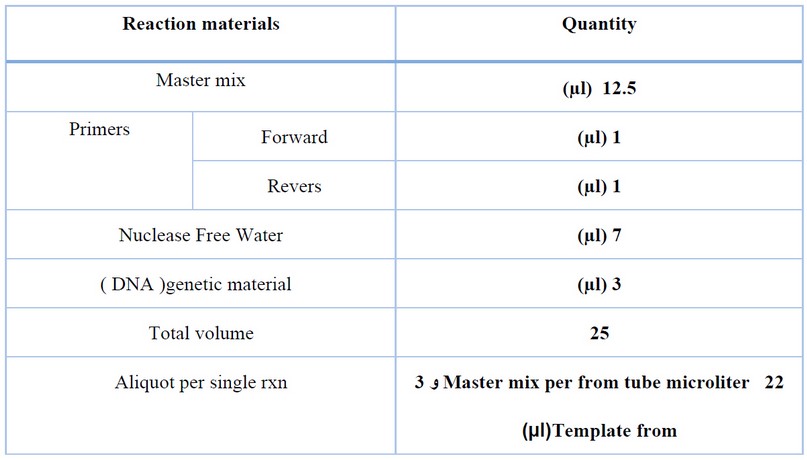
Table 2. Materials used in the polymerase chain reaction (PCR) for the third segment of the HSP70. Gene
The data on reproductive performance traits, milk production and growth traits were analyzed using the general linear model (GLM) within the statistical program (SAS) (2012) according to the following mathematical model:
Yim= µ+Gi+eim
Yim= observation value of m
µ= overall mean
Gi= effect of genotypes
eim= The random error which is normally distributed with an average of zero and a variation of e2
The theChi-square-x2 test was used to compare the percentages of the genotype distribution of the studied gene mutation from the third segment of the HSP70 gene. The significant differences between the means were compared using Duncan's test (1955). The gene frequency for the studied region was calculated according to the following law
A repeat of the first allele

As for the frequency of the second allele, it was according to the equation
qB= 1- PA
RESULTS
The extraction process was carried out successfully for the studied goat sample, consisting of 30 goats, using the diagnostic kit mentioned in the working materials and methods. 100 volts 50 mA for 60 minutes, and then the limited piece of HSP70, which had a size of 903 bp, was determined and amplified as shown in Figure (1) (2) (3) using PCR technology.
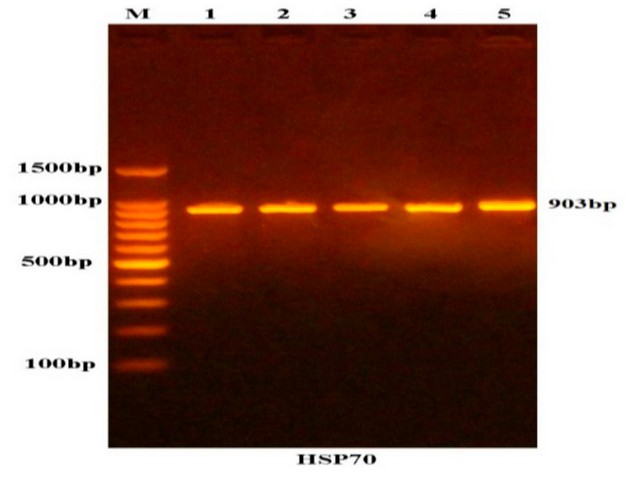
Figure 1. Detection of the product of PCR by electrophoresis on agarose gel, where M represents the standard DNA size of 100-1500bp (1-5) represents the DNA bands of HSP70 gene, which appears in size 903bp for 30 samples of female goat.
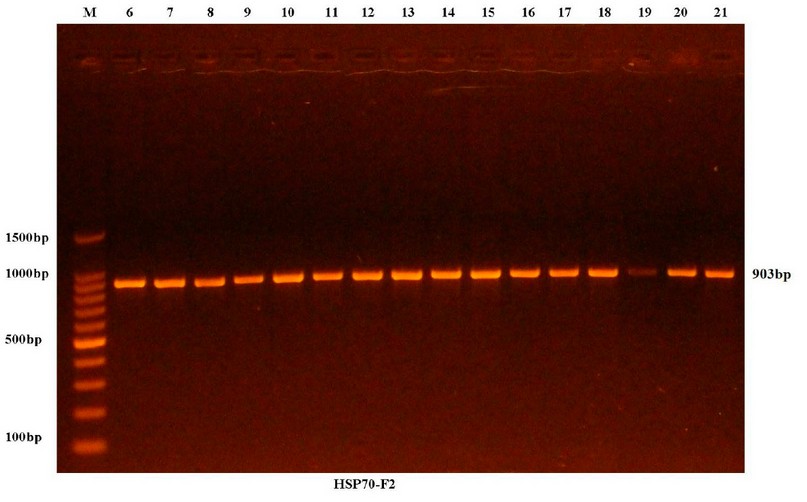
Figure 2. Results of the amplification of HSP70 specific region of Bos taurus samples were fractionated on 1.5% agarose gel electrophoresis stained with Eth.Br. M: 100bp ladder marker. Lanes 6-21 resemble 903bp PCR products.
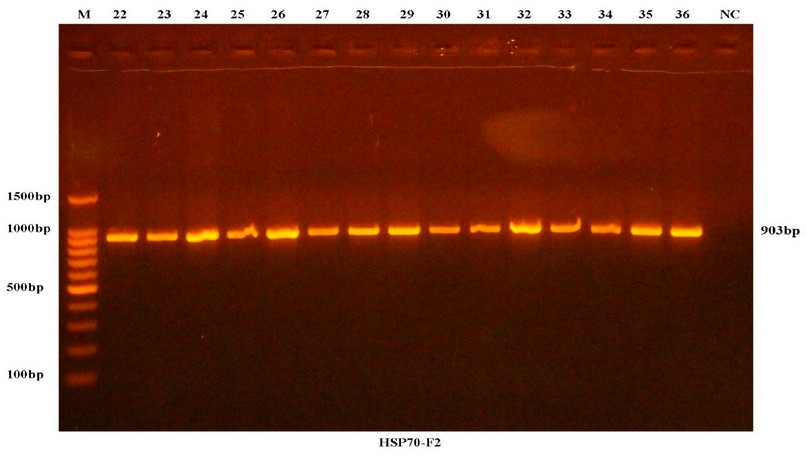
Figure 3. Results of the amplification of HSP70 specific region of Bos taurus samples were fractionated on 1.5% agarose gel electrophoresis stained with Eth.Br. M: 100bp ladder marker. Lanes 22-36 resemble 903bp PCR products.
The site of heterogeneity of the SNP in the third segment of the HSP70 . gene
The site (C1653T) contained three genotypes: CC (Wild), CT (Heterozygous) and recessive TT (Mutant), as the nitrogenous base changed from C to T.
Figure 4. Analysis of the 1653 SNP locus of the HSP70 gene using Sanger sequencing. A single C peak is indicative of a homozygous C allele. A single T peak indicates a homozygous T allele, and a C peak and a T peak indicate a heterozygous T/C allele.
Number, percentage and allelic frequency of the genotypes in the third segment of the heat shock gene (HSP70).
The percentage of genotypes for the C1653T mutation site in the goat sample was 53%, 37%, and 10% for the CC, CT and TT genotypes, respectively, and the allelic frequency was 0.71 and 0.29 for the C and T alleles, respectively. Hybrid CT and low percentages of TT genotype and that the value of chi-square did not have a significant difference between the genotypes, which indicates that the population was in a state of equilibrium (Hardy Weinberg) (P < 0.05), which suggests that there is no selection pressure in favor of a specific genotype for this locus.
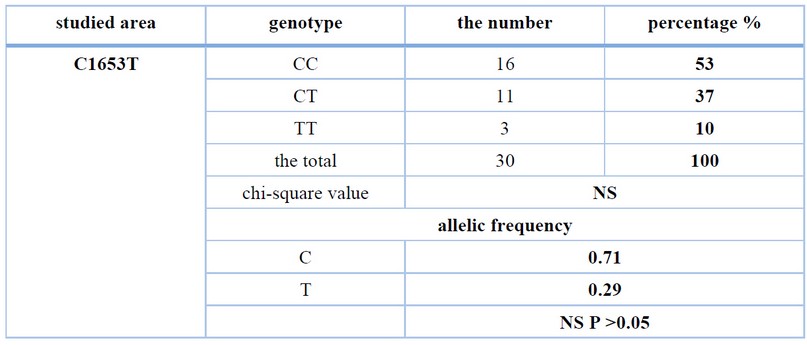
Table 3. The number and percentage of the HSP70 gene for the C1653T mutation site in the studied sample of female goats.
Relationship of the C1653T mutation in the third studied segment of the HSP70 gene on the reproductive performance of goats.
Table (4) for the third mutation C1653T showed a significant effect (P < 0.01) in the percentage of deaths and that this percentage resulted from dividing the number of dead births by the number of births generated × 100, where the CT genotype outperformed by 27% on each of the two genotypes CC, where It was 13%, then TT had no fatalities. As for the other percentages, there are no significant differences
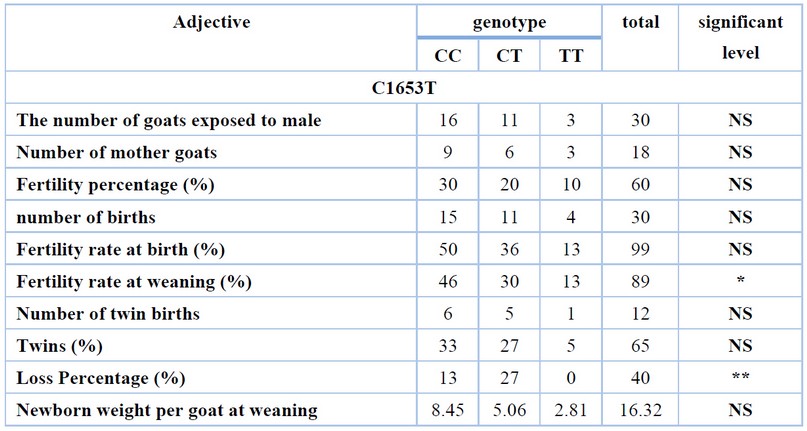
Table 4. The effect of the C1653T mutation on the reproductive performance of goats.
Newborn weight per goat at weaning
Relationship of the C1653T mutation in the third studied segment of the HSP70 gene on daily and total milk production.
The present study showed that no-significantly differences to C1653T in daily and total milk production and lactation period traits (Table 6). The site of mutation was a balance for this mutation concerning the product characteristics (milk production) and resistance to heat stress, so this mutation worked in this direction so that there is resistance to heat stress. This negatively affected milk production, as the animal was in a state of balance between resistance to heat stress and milk production. Accordingly, according to the mutation that occurred, we did not notice any significant differences in milk production for different groups of goats.
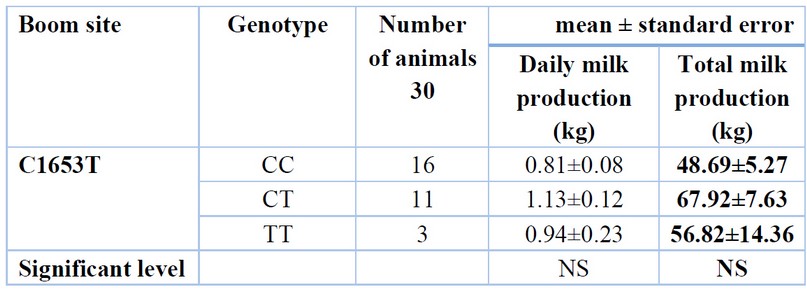
Table 5. the mean ± standard deviation of the total and daily milk produced for the experimental animals.
The relationship of the studied mutation C1653T in the third studied segment of the HSP70 gene in growth traits
The results of the statistical analysis in Table (7) showed that there was no significant effect of the C1653T mutation on growth characteristics. There were no significant differences between the genotypes of birth weight and weight gain, but with regard to weight at weaning, it was noted that the CC and TT genotypes were superior to the structure. The CT genotypes were (11.92, 11.70, and 10.17) kg, respectively

Table 6. the mean ± standard deviation for (birth weight(BWT ), weaning weight(WWT), and weight gain(WG ).
DISCUSSION
It was shown from Table (4) that there were significant differences (p > 0.01) in the percentage of mortality. It was noted that the TT genotype was superior, as there were no deaths for the two genotypes, CC and CT. As for the fertility rate at weaning, it was noted that there were significant differences (p > 0.05), and it was pointed out that the genotype was superior CC on the other two combinations, CT and TT, while in the rest of the proportions, there were no significant differences. Regarding milk production (daily and total), as shown in table (5), it was observed that there were no significant differences. A balance was achieved between milk production and resistance to heat stress, and this is consistent with Contreras-jodar 2018 10. The animal is in a state of resistance to heat stress, which negatively affects milk production and its components, so there is a balance for the animal in resistance to heat stress and milk production for the different groups of goats according to the mutation that occurred. As for the growth characteristics, as shown in Table (6), There were no significant differences in birth weight and weight gain. As for weaning weight, it was noted that the genotypes CC and TT were superior to the genotype CT, reaching (11.70 and 11.92), respectively, over the genotype CT, which is 10.17.
CONCLUSIONS
We find the superiority of the goats carrying the TT genotype in the C1653T mutation, as no deaths were recorded. We also see the superiority of the goats carrying the CC genotype in the fertility rate at weaning. We also find the superiority of the goats carrying the CC and TT genotypes in the weaning weight of the same mutation. We find the superiority of the genotype CC and TT concerning weaning weight, which has an economic return for the breeder
REFERENCES
1. Alam, M. M.; M. A. Hashem; M. M. Rahman; M. M. Hossain; M. R. Haque; Z. Sobhan; and M. S. Islam. Effect of heat stress on behavior, physiological and blood parameters of goat. Progressive Agriculture, 2011 , 22(1- 2),37-45.
2. Al-Hamdani, Wahbi Abdel-Qader. Studying the effect of some environmental Milk and its composition in genetic groups of goats. 2000, PhD hesis. faculty of Agriculture .Baghdad University . Iraq .
3. ECSD. Livestock Development Program in the Arab Countries, 1996 , Annual Technical Report, Damascus.
4. Gerreiro, E. N.; P. F. Giachetto; P. Givisiez; J. A.Ferro; M. I.Ferro; J. E. Gabrie; R. L. Furlan and M. Macari. Brain and hepatic
Hsp70 protein levels in heat-acclimated broiler chickens during Stress. 2004 , Braz. J. Poult. Sci. 6(4):201-206.
5. Gupta, M. and T. Mondal. Heat stress and thermoregulatory responses of goats: 2019 , a review, Biological Rhythm Research
https://doi.org/10.1080/09291016.2019.1603692
6. Khalil Z. S. and S. H. Jassim. Estimate of genetic parameters and some non-genetic factors to produce milk and its components in the local and shami goats centeral Iraq. 2018, Diyala Agricultural Sciences Journal, 10(2), 26-35.
7. Khazraji, W. J. A.; H. M.AL-Khuzai and M. A. AL-Shaikh. Analysis of Genetic Variance for Milk Production And it Components in Local Goat For Prolactin Gene. 2020, Diyala Journal of Agricultural Sciences, 12. (A special issue of the proceedings of the Fourth Scientific Conference on Agricultural Research).
8. Sas.2012.Statistical Analysis System, Users Guide . Statistical . Version 9 .1th ed . SAS . Inst . Cary . NC. USA.
9. Duncan, D. D. 1955. Multiple range and multiple F-test Biometrices.11: 1-42.
10. Contreras-jodar , a. a. ak:s. salam ; m. hamzaoui ; vailati – riboni ; G.caja and j. j. loor . 2018 . effects of chronic heat stress on lacation al perfor mance and the transcriptomic profile of blood cells in lactating dairy goals . journal of dairy research . 85:423-430 .
Received: August 25, 2022 / Accepted: October 12, 2022 / Published:15 November 2022
Citation: Waheb O R, AL-Azzawi S H. Detection of heat shock protein 70 genes (HSP70) polymorphism and its relationship with some productive and reproductive traits in local Iraqi goat. Revis Bionatura 2022;7(4) 50. http://dx.doi.org/10.21931/RB/2022.07.04.50
